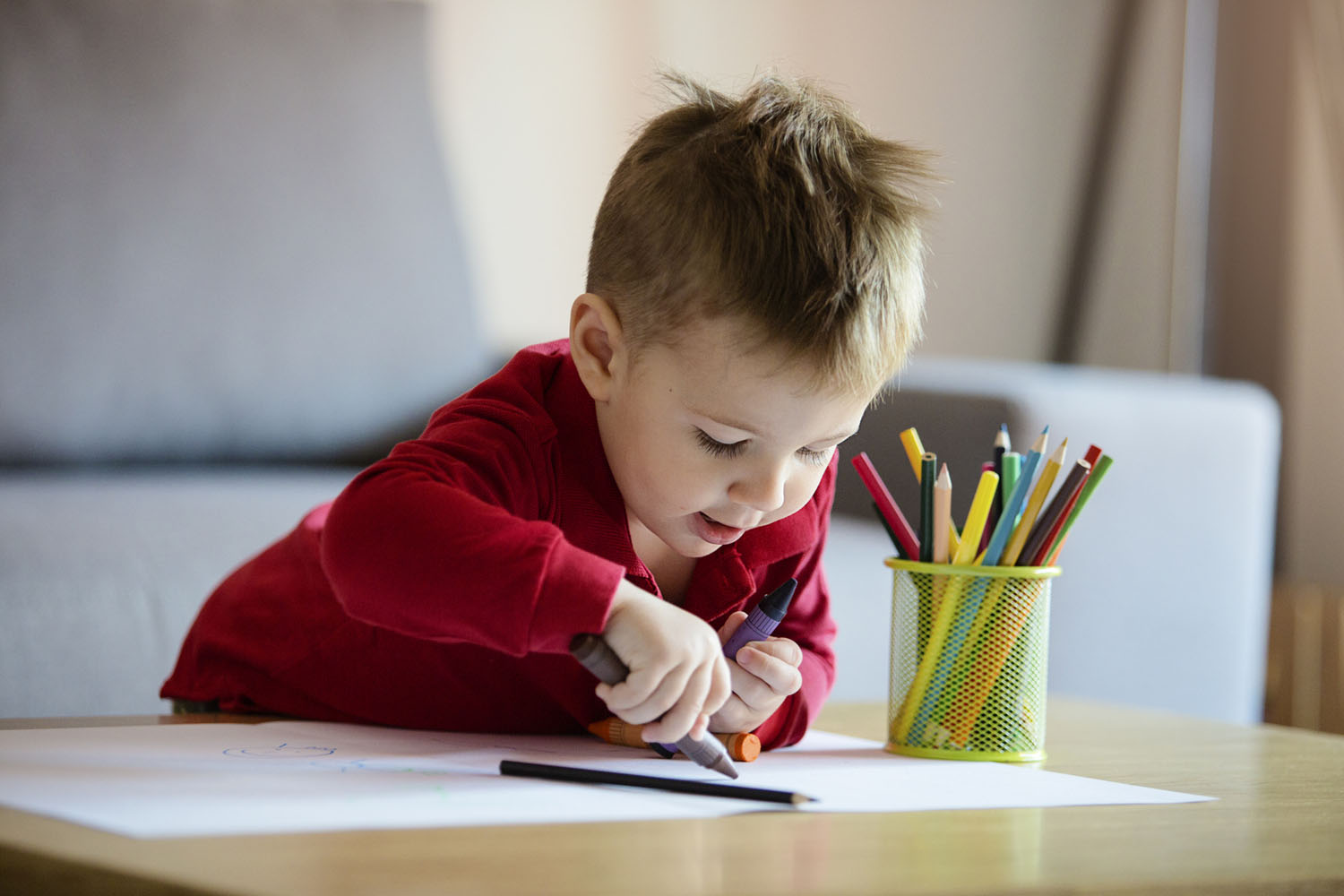From scribbler to Writer – How Mark Making Turns into Drawing and Writing

Many parents wonder if there is a particular age that children should be able to draw and hold writing tools competently. Well, the answer to that that is, children gradually progress through a range of stages before they are physically able to hold a pencil, paintbrush, crayon or pen to write letters, numbers or draw recognisable figures. It’s important to remember that all children are different and develop at their own unique pace.
Children begin their journey towards writing via making marks, not forming letters and words. You may have noticed that babies love to make marks in spilled food, splatting spilled liquid, touching it with their fingers and palms of their hands, and creating patterns. This sensory experience of seeing the marks their fingers make is a vital part of their learning journey, so you can view this as making a mark – not a mess!
The marks your little one makes will begin to have more meaning for them as they progress. Young children are active learners who learn through their actions and these actions will help them to develop their inner body core and become ready to competently hold a pencil or brush with time.
5 Activities That Can Help Children Become Mark Makers
To help your child develop their inner body core to be able to hold mark making tools, they’ll need to exercise large motor movements that support the development of their SHOULDERS, ELBOWS, WRISTS then eventually FINGERS.
Babies and children need opportunities to make BIG movements on BIG canvasses like large sheets of paper, rolls of old wallpaper/lining paper or ground sheets.
Here are some more activity ideas…
- Activities that require using their hands and arms to explore paint and sensory materials, for example: gloop (cornflour and water) that make marks, are fantastic for developing shoulders and elbows.
- Children love to help around the house with simple tasks. You can give them little jobs to do like helping to sweep up leaves with the dustpan and brush or a child-sized broom. This activity is ideal for developing those shoulder and elbow muscles, strengthening the arms and developing inner body coordination.
- Providing a small bucket of water and a small domestic paintbrush can provide hours of fun, particularly when it’s sunny and the water dries quickly. Encourage your child to ‘paint’ the slabs, fence or wall using their big movements to develop wrists and upper body strength.
- Make a batch of playdough and play ‘Dough Disco’ (yes, you read that correctly)! Dough Disco is a fun way to help your little one to develop movements that cross the mid body line and also support fine motor skills (developing finger control) necessary for writing.
- Children also love to use salad tongs and small tweezers to pick up small objects and transport them from one container to another like pompoms in bun trays or moving small buttons or dried pasta from one place to another. This kind of activity can further support their fine motor development, as well as hand to eye coordination.
*Note: When using small items at home, please ensure that children are well supervised
Learning to Hold Mark Making Tools
Once children have progressed through various foundational stages of mark making and early drawing, they will also go through a range of stages in holding writing tools. They will use a grip that is within their stage of development, and which feels most comfortable to them. They will almost certainly still be deciding which hand they prefer to use, but young children will often swap hands and use both.
Palmar Grasp
Younger children and babies will generally hold mark making tools using a whole hand grip called a ‘Palmar grasp’ This grip is a strong grip that helps them to hold the tools firmly and make marks. At this developmental stage, try to offer your child a range of different opportunities to make marks. The smaller the hand, the bigger the tool needs to be, to enable small hands the ability to grasp comfortably.
Tripod Grip
This is the next stage of development in holding mark making tools. Children will often use what we call a ‘tripod grip’ using three fingers, usually holding at the top of a pencil, crayon or chalk. By this stage, they will likely be using their ‘dominant hand’, the one which feels most natural to use. However, if they are still experimenting with both hands, that’s perfectly fine. Give them opportunities to use a ‘still hand’ and a ‘moving hand’ like screwing bottle tops on or using a padlock and key. Activities like this will continue to support their fine motor skills.
Pincer Grasp
This involves the coordination of the index finger and thumb to hold the writing tool. This grip requires multiple skills including finger strength and precise control in the hands. That’s where all that ground work from the BIG movements, developing shoulders, elbows and wrists will have paid off.
At this stage, your child will have more control over their hands and fingers, so will be able to make marks on smaller canvasses and become increasingly skilful in controlling their writing tools and beginning to form recognisable marks and possibly some letters or numerals.
The role of parents and carers in helping young children to become competent and confident mark makers and writers is vital. You can support your child at home by providing some of these ideas to develop their skills at each stage of development and at their own unique pace. Please ask your child’s Key Worker if you would like some additional ideas for home learning around writing and drawing.
Happy mark making!
Related Articles
Encouraging An Early Interest In Writing
Writing in The Sand – Growing Writers
Writing a Shopping List





